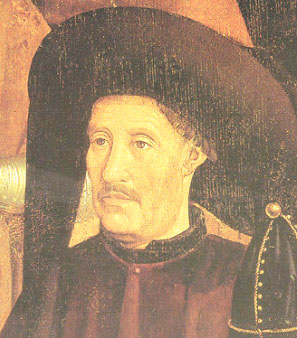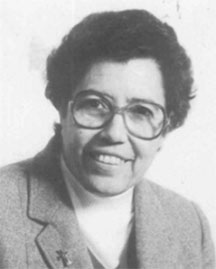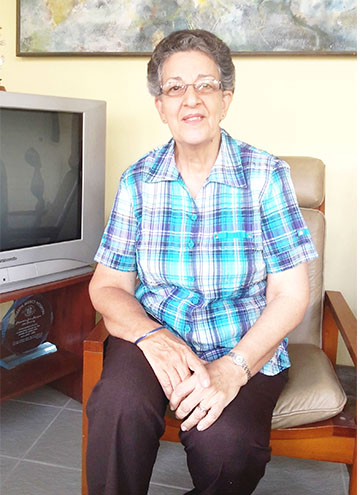Today marks 180 years of the arrival of the Portuguese in Guyana. In an interview with the Sunday Stabroek, third generation Portuguese descendant Joan Rodrigues shares her reminiscences
As a child growing up Joan Rodrigues—she was Joan Gomes then—remembers her grandmother saying the Holy Rosary in Portuguese and looked forward to the days when she took over the kitchen and lavished them with Portuguese cuisine.
It was from her grandmother, who was not actually born in Portugal or Madeira (a cluster of islands in the North Atlantic Ocean, west and slightly south of Portugal) but in Berbice that this then young descendant was introduced to some Portuguese culture.
“So we picked up a few words in Portuguese which I wouldn’t worry to repeat because I would probably say them wrong. And I recall her speaking Portuguese with her niece who had come from Trinidad,” she told the Sunday Stabroek in a recent interview. She did not understand the conversation and recalled that they only knew the spoken word and could not have written in Portuguese.

Rodrigues said some Portuguese came to British Guiana and others went to Trinidad. Her grandmother’s parents came from Madeira, but she was born in Berbice and her father was the captain of a ship.
According to Rodrigues, quite a few fishermen from Portugal settled in Guyana; a lot of them had settled in Albouystown and attended the Our Lady of Mount Carmel Church at Meadowbank.
Growing up, she recalled, there were certain days when her grandmother did all of the cooking preparing dishes like carne de vinha d’alhos (garlic pork) which was eaten with aniseed bread, topped off with a touch of gin.
“No matter how young you were, you were given a little bit of gin because that was their custom,” Rodrigues recalled with slight laughter.
Her grandmother also made dishes like pancakes with syrup, which looking back, Rodrigues now refers to as a “kind of splurge in the sugar.” She also made special salt fish stew or a “kind of fry-up salt fish and you ate it with boiled eggs.”
Rodrigues is one of the few Portuguese descendants who remain in Guyana today 180 years after they arrived on these shores.
In an article published in this newspaper some 5 years ago, Sr Mary Noel Menezes—a Sister of Mercy who has also written books on the history of the Portuguese in Guyana—said that on May 3, 1835, after a voyage of 78 days, the Louisa Baillie docked in Demerara with 40 Madeiran emigrants bound for ‘Pln Thomas’ of RG Butts and for ‘Plns La Penitence’ and ‘Liliendaal’ of James Albuoy. Sr Mary Noel, who is also Professor Emeritus at the University of Guyana, wrote that they made the move for three reasons: the approaching abolition of slavery throughout the British possessions creating a labour gap; the long-standing alliance between Portugal and England; and the political, military and economic problems in Madeira in the 1830s.
Custom

As she pieced together what she knows of Portuguese ancestry, Rodrigues, who made it clear that she is Guyanese first and foremost, recalled that every year her grandmother, who lived with Rodrigues’s parents and their five daughters in Ornoque Street, had a dish exchange with her friend. Her grandmother would give garlic pork while her friend would return the favour with bolo de mel – a very thick black cake that was made with molasses, honey and ginger.
She enjoyed it as a child but Rodrigues said she has not had bolo de mel in a few years because the people who knew how to make such dishes have now moved on.
Both her maternal and paternal grandparents were of Portuguese origin, but Rodrigues said her father’s father had died when he was very young and his mother had immigrated to England to work so she knew little about them. Her maternal grandfather had also died when her mother was young as well.
She recalled that her grandmother lived with her family until she was 88 and then left Guyana for Canada where two of her children lived and she died at age of 94 in that country.
“She lived a full ripe life,” she said of her grandmother whose name was Madeleine Rebeira.
Her grandmother had three children – two girls and one boy and none are alive today.
According to Rodrigues, the Roman Catholic Church had a lot to do with Portuguese being in Guyana.
“The Catholic Church was the one that brought [people of] Portuguese ancestry to Guyana… We had Italian Jesuit priests, but there were Portuguese who had come to Guyana who brought their culture of praying the Rosary in Portuguese and there was a certain hymn we sang at Novena every year…,” Rodrigues said. She said up to recently that song was still being sung at the Brickdam Cathedral.
 Rodrigues said most of what they learnt was from the Catholic Church. As a child, she attended the Sacred Heart Roman Catholic School where from around the age of six they took part in processions that were a part of Portuguese customs. One such procession involved the honouring of Mary and crowning the statue.
Rodrigues said most of what they learnt was from the Catholic Church. As a child, she attended the Sacred Heart Roman Catholic School where from around the age of six they took part in processions that were a part of Portuguese customs. One such procession involved the honouring of Mary and crowning the statue.
“But as children we were dressed in Portuguese costumes and it was the Portuguese children who did the things like crowning the statue and garlanding the statue. But in addition to that all the children, regardless of their ethnic background and their religious persuasion, they all took part in the procession because we were all from the same school,” she recalled.
After Sacred Heart, Rodrigues went to St Joseph High, another Catholic school, and she said it was those schools that many of the Portuguese children attended.
According to Rodrigues, as it relates to Guyanese of Portuguese descent looking up their ancestors, only those who were better off might have travelled to Madeira or Portugal and this was done in later years that her family or her husband’s family would have made such trips.
“…I have never been myself and to tell you the truth, I don’t really have a yearning to go. I don’t know enough to have that yearning. I grew up as a Guyanese and our friends were particularly Guyanese…,” Rodrigues said when asked if she would have made such a trip.
By accident
She said it was by accident that she married someone of Portuguese ancestry – well-known architect Albert Rodrigues. She had attended school with his sisters and their siblings were also friends. Her first job was at the then Royal Bank of Canada, where she worked with his brother through whom met her future husband.
“But as I said it was just by accident that he is Portuguese too and his family is from Madeira as well,” she said.
Forty-eight years and two sons later they are still together and work together at Rodrigues’ Architects Ltd, a stone’s throw away from the Bel Air home they have lived in all their married life in Guyana. She is the company secretary of the business.
The Rodrigues’s lived two years in England while Albert completed his studies. They got married after a whirlwind courtship during her husband’s year out from his studies.
For her, the Catholic Church would have had an influence on her life. As to whether there is any Portuguese custom she still observes, the grandmother of four said her husband still makes garlic pork every Christmas and they still cook the salt fish stew eaten with boiled eggs. But Rodrigues is not involved in any activity that focuses on keeping the tradition alive.
She revealed that one of their sons is married a Brazilian who speaks Portuguese and said jokingly that she should really learn the language to converse with her daughter-in-law properly; she added that one of her grandchildren understands the language fairly well.
Rodrigues attends the Holy Rosary Church in Kitty where she is a catechist and has been for almost 35 years and she also sings in the church choir. She is also the chairperson of the management committee of the Cheshire Home for disabled persons located in Mahaica.
“We live a very simple life,” she said of herself and husband, further stating that all of their relatives live abroad.
She is one of five sisters—one is deceased—while her husband is one of nine siblings.
Some years ago Sr Madeleine Rose had put on a show to mark the anniversary of the Portuguese coming to Guyana and Rodrigues remembers one of her sons being a part what was known as a pageant which involved a big ship.
There are too few Portuguese descendants to keep the tradition alive, Rodrigues said adding that it is unfortunate that they don’t have a group of people who focus on this like the other ethnic groups. “There are just too few of us…,” she said forlornly.
She recalled that many persons of Portuguese ancestry were very successful in business. Banks DIH is one such example. It was founded by the late Peter D’Aguiar, who was of Portuguese descent and there is also the John Fernandes’ empire – including shipping and Bounty Farms and Supermarkets. Many of the Portuguese descendants also owned shops in the Albouystown area.
Sr Mary Noel in her 2010 piece had said that in the early years it was mainly in the rum trade that the Portuguese made their mark. By 1852, 79% of the retail rum shops were owned by the Portuguese and they retained that monopoly well into the twentieth century.
“The end of the 1860s and the 1870s saw the Portuguese well entrenched in business. The roster of Portuguese entrepreneurs was extensive. Apart from being property owners, they were provision and commission merchants, spirit shop owners, importers, iron mongers, ship chandlers, leather merchants, boot and shoe makers, saddlers, coachbuilders, woodcutters, timber merchants, brick makers, cattle owners, pork-knockers, charcoal dealers, bakers and photographers,” she wrote.
According to Sr Mary Noel in the 1960s and 1970s the Portuguese suffered discrimination and many crossed the ocean in search of another EI Dorado in the north, “maybe in the spirit of the early Portuguese explorers who lived to the hilt the motto of Prince Henry the Navigator: ‘Go farther’.”




